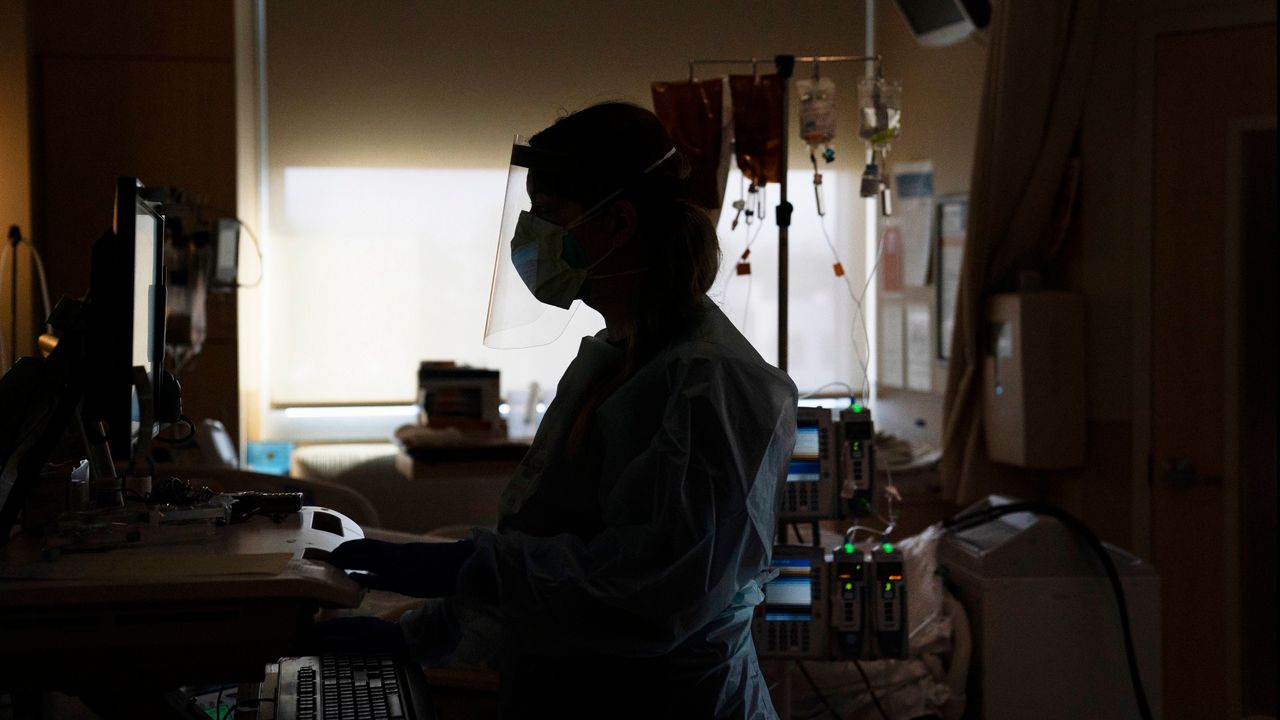MILWAUKEE — The delta variant put a damper on Wisconsin’s “new normal.” The omicron variant sent COVID-19 cases higher than they’d ever been — by a long shot.
But for the first time in a long time, Wisconsin’s pandemic numbers are heading in the right direction. Just as quickly as cases surged, they’ve fallen back down in recent weeks, bringing severe outcomes with them.
What You Need To Know
- Cases, hospitalizations and deaths have all seen a sharp decline in the past month as the omicron surge subsides
- Vaccinations have slowed down, even though most Wisconsinites have not been boosted
- The CDC has loosened its mask requirements as several mandates have expird across the state
- The extra-contagious BA.2 subvariant of omicron hasn't spread widely
Amid these promising trends, mask guidelines have started to loosen up, although vaccination and booster rates have stalled out once again.
Here, we break down these latest COVID-19 trends and other updates you should know in the Badger State.
A sharp dropoff from omicron’s peaks
To kick off the year, the omicron variant brought some of the highest COVID-19 levels Wisconsin had ever seen. But since then, the Badger State has seen a quick turnaround, with pandemic numbers plunging back down in recent weeks.
As of Monday’s DHS data, the average daily case count sat at 645 — the lowest in around half a year. Since the start of February, the case average has dropped more than 87%.
Severe cases have also been on the decline. Hospitalizations and intensive care patients have dropped by more than 75% each since their omicron peaks, while deaths are down by more than 60%, according to statewide data.
After becoming one of the hottest hotspots in the country for new cases earlier in the year, Wisconsin is now faring better than most states, according to a New York Times tracker. And wastewater data shows some optimistic trends, too: Almost all of the sewersheds in the state’s dashboard were seeing their viral levels head down in the latest update.
“Our numbers are getting much better in the county, across the board,” Ben Weston, chief health policy advisor for Milwaukee County, said at a briefing Tuesday.
Kids under 18 are still seeing the highest counts, the DHS reports, and have experienced the most total cases over the course of the pandemic. The threat of MIS-C — a rare inflammatory condition linked to COVID-19 in kids — is still a concern, too, with Wisconsin reporting its first MIS-C death last month.
The outlook for Wisconsin’s youngest residents is improving, though: Children’s Wisconsin is reporting fewer kids in the hospital in recent weeks, and the weekly total for student cases in Milwaukee Public Schools is down almost 90% from the end of Januar
The state still has a ways to go before reaching lows like we saw over the summer, when vaccines were rolling out and variants hadn’t shown up yet. By DHS standards, every county is still seeing “high” or “very high” disease activity — which is better than “critically high,” but still leaves room for improvement.
“We need to remember that we just settled from a tidal wave of cases,” Weston said. “We should be cautious before assuming that another storm will not come.”
Vaccines and boosters still slowing down
With booster shots opening up and omicron looming, vaccinations in Wisconsin saw an uptick at the end of 2021. But in recent weeks, the pace of shots in arms is about as slow as it’s ever been — even with many Wisconsinites still unvaccinated or unboosted.
The state has stalled out at around 60% of all residents having completed their initial vaccine series — placing Wisconsin around the middle of the pack compared to the rest of the country, according to a New York Times ranking.
Kids aged 5 to 11 are lagging far behind other age groups in vaccine coverage. Around 23% of these youngest eligible Wisconsinites have completed the initial vaccine series, according to the DHS.
As of Sunday, vaccinators were giving out an average of 3,747 doses each day, the DHS reports. That’s slower than even the summer lull, when the initial rush for doses was leveling off and boosters were not yet available.
While boosters were making up a big share of shots in arms for a while, they’ve seen a steep decline since the start of the year, per DHS data. The daily average for boosters and additional doses has dipped by almost 70% since the start of February. The daily average for all vaccinations is down more than 60% in that same time period.
Last week, the DHS added more information about how boosters are going in Wisconsin. According to their data, around 33% of all residents in the state have gotten a booster or additional dose.
Just like with the original vaccine series, older Wisconsinites are more likely to have an extra dose, per DHS data: More than 66% of those 65 and older have gotten a booster or additional dose, compared to just 17% of adolescents 12 to 17.
Across the country, fewer than 30% of all residents have gotten a booster dose, according to CDC data.
Mask rules loosen up
Amid vaccine protections and dropping case counts, new guidelines are loosening mask requirements in Wisconsin and beyond.
Local mask mandates in Milwaukee and Dane County came to an end on Tuesday. And many schools across the state — including UW System campuses — are phasing out mask requirements as the omicron surge has tapered off.
Last week, the CDC also updated its recommendations for when counties should mask up. Their latest guidelines only advise universal indoor masking when communities are seeing a high level of COVID-19 — and also changed how that risk level is calculated.
The agency’s earlier risk rankings focused on COVID-19 case counts and percent positivity. But the new metrics focus on severe outcomes, putting more weight on hospitalizations and hospital capacity.
“With widespread population immunity, the overall risk of severe disease is now generally lower,” CDC Director Rochelle Walensky said in a briefing announcing the updates. “Now, as the virus continues to circulate in our communities, we must focus our metrics beyond just cases in the community.”
Under these new categories, around 70% of Americans now live in areas that are considered low or medium risk, according to the AP — which means they’re not required to wear masks under the new rules. That includes around three-quarters of counties in Wisconsin, per the CDC’s risk map.
Milwaukee Health Commissioner Kirsten Johnson still urged “a note of caution” moving forward.
“I want to stress the importance of approaching masking respectfully,” Johnson said at Tuesday’s briefing.
Local authorities, businesses and schools can continue to set their own mask guidelines, and masks are still required for travel settings like airports and buses, the CDC advises. Those at high risk for COVID-19 may still want to mask up at lower levels of community spread, Weston pointed out, and others may still wear masks out of concern for vulnerable groups.
Plus, our current risk levels may not last forever, officials pointed out.
“None of us know what the future may hold for us and for this virus,” Walensky said at the briefing. “We want to give people a break from things like mask wearing when our levels are low and then have the ability to reach for them again, should things get worse in the future.”
Keeping tabs on variants
Sequencing data in Wisconsin makes it clear: Omicron is still on top when it comes to coronavirus variants.
The variant of concern has made up 100% of sequenced samples in recent weeks, according to tracking data from the Wisconsin State Laboratory of Hygiene. Since the start of the year, it’s held onto its spot as the dominant variant in the state.
One version of omicron, BA.2, did raise some alarm bells when it arrived in the Badger State at the end of January. Studies have shown that the subvariant has a lot of genetic differences from other versions of omicron and is even more transmissible — causing some concern that it could slow down our recovery after the latest surge.
But so far, BA.2 hasn’t made too much of a dent in Wisconsin. The subvariant made up around 2% of sequenced cases in February, according to the statewide dashboard.
Across the country, CDC data shows that BA.2 has been gaining some ground compared to other versions of omicron, but still represents under 10% of all cases. And recent research has suggested that those who were previously infected with BA.1 — the more widespread version of omicron — were well protected from BA.2.
Even if BA.2 doesn’t spark a surge, though, keeping an eye out for new versions of the virus will be key to the future of the pandemic.
“We will see and be affected by other variants in the future,” Weston said. “But in the meantime, we can be nimble in our mitigation strategies and respond to the disease burden in the community.”









